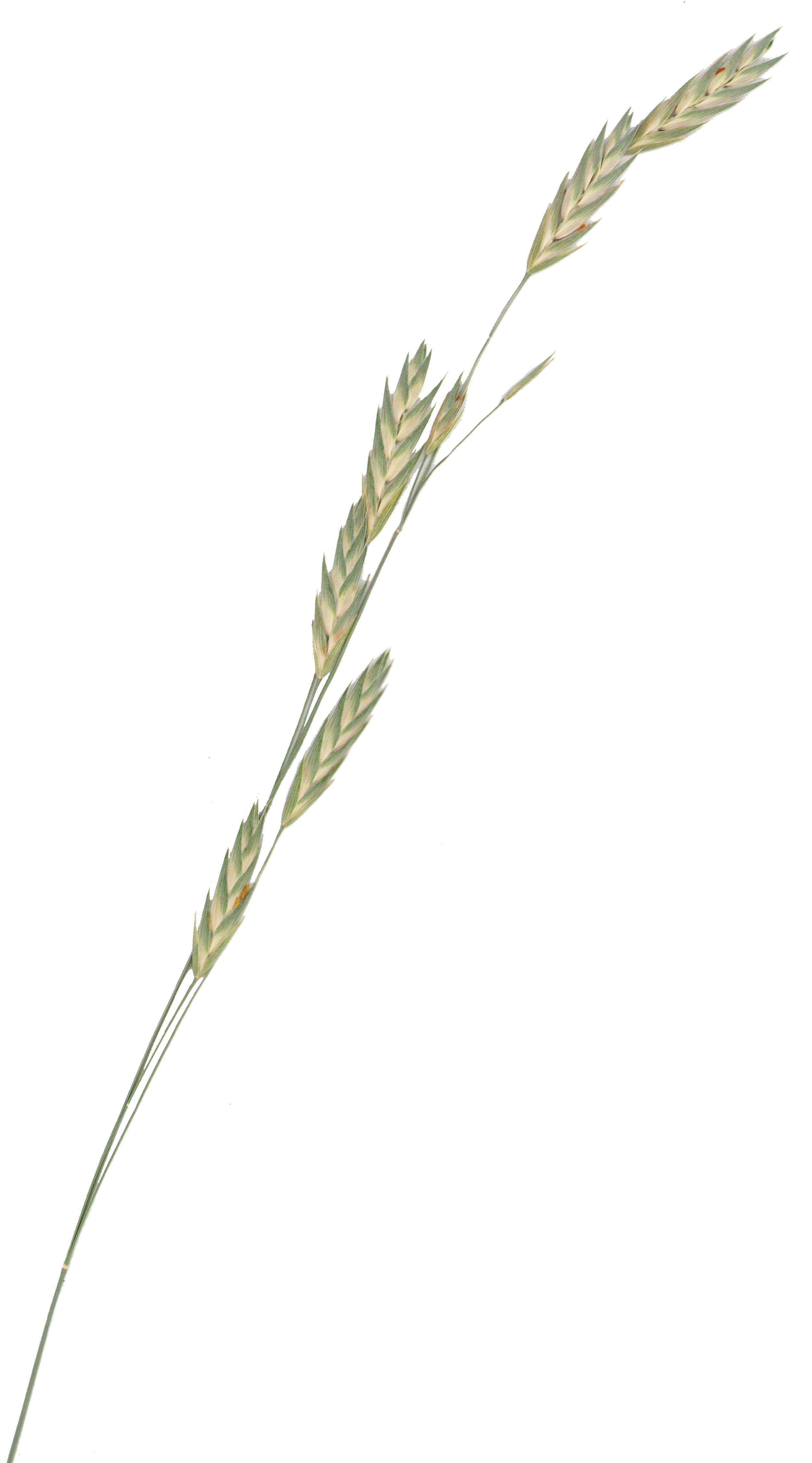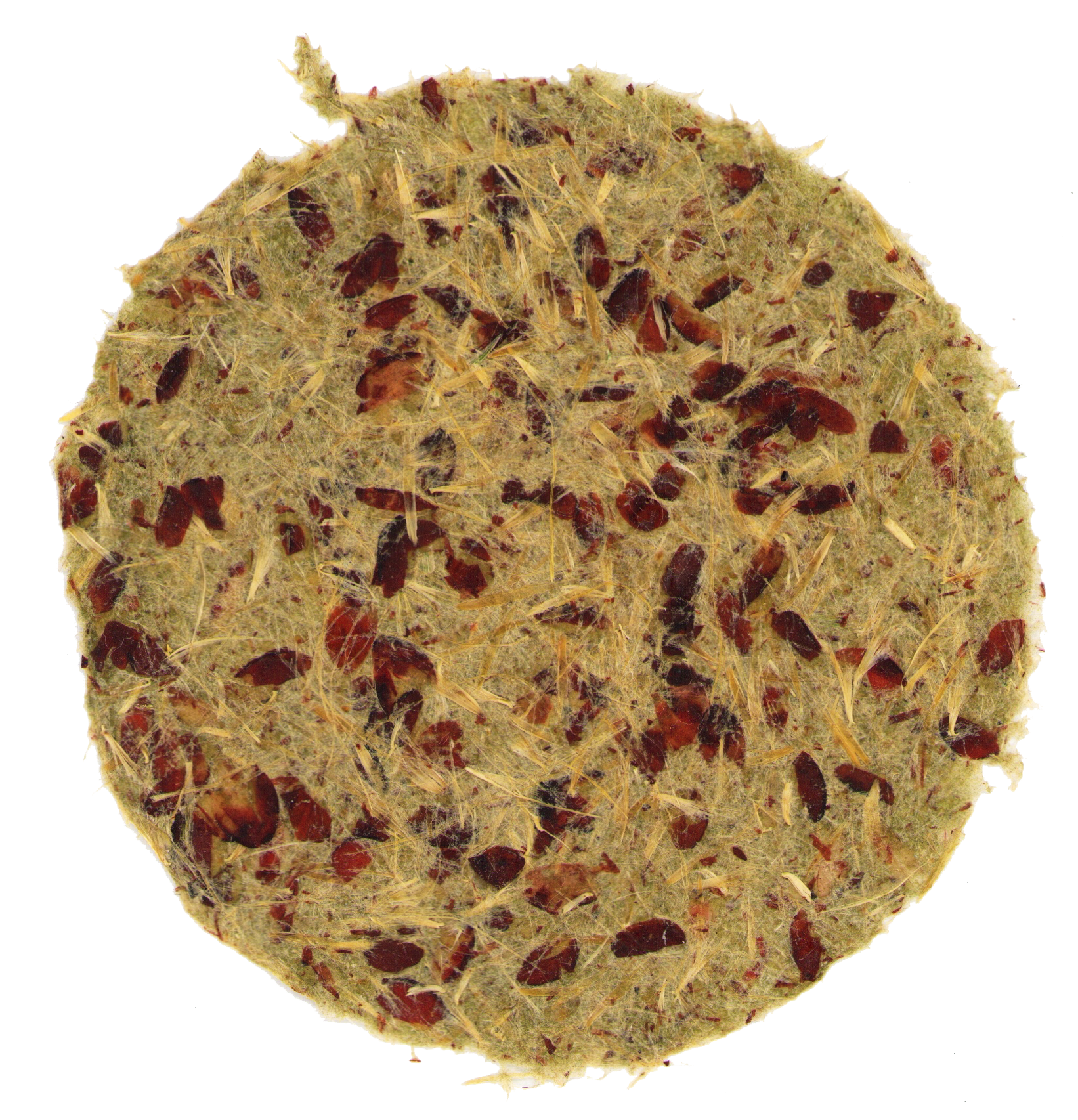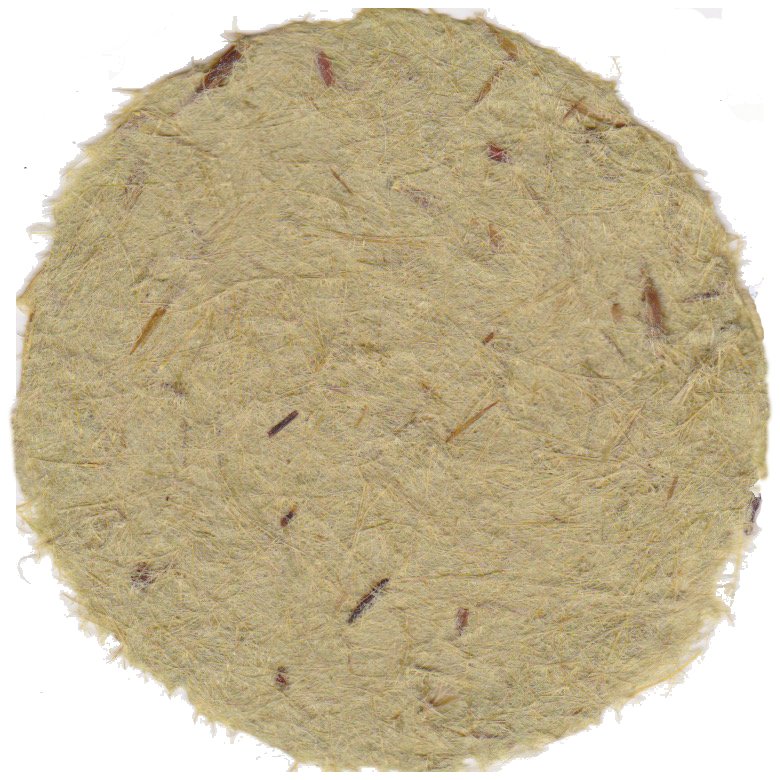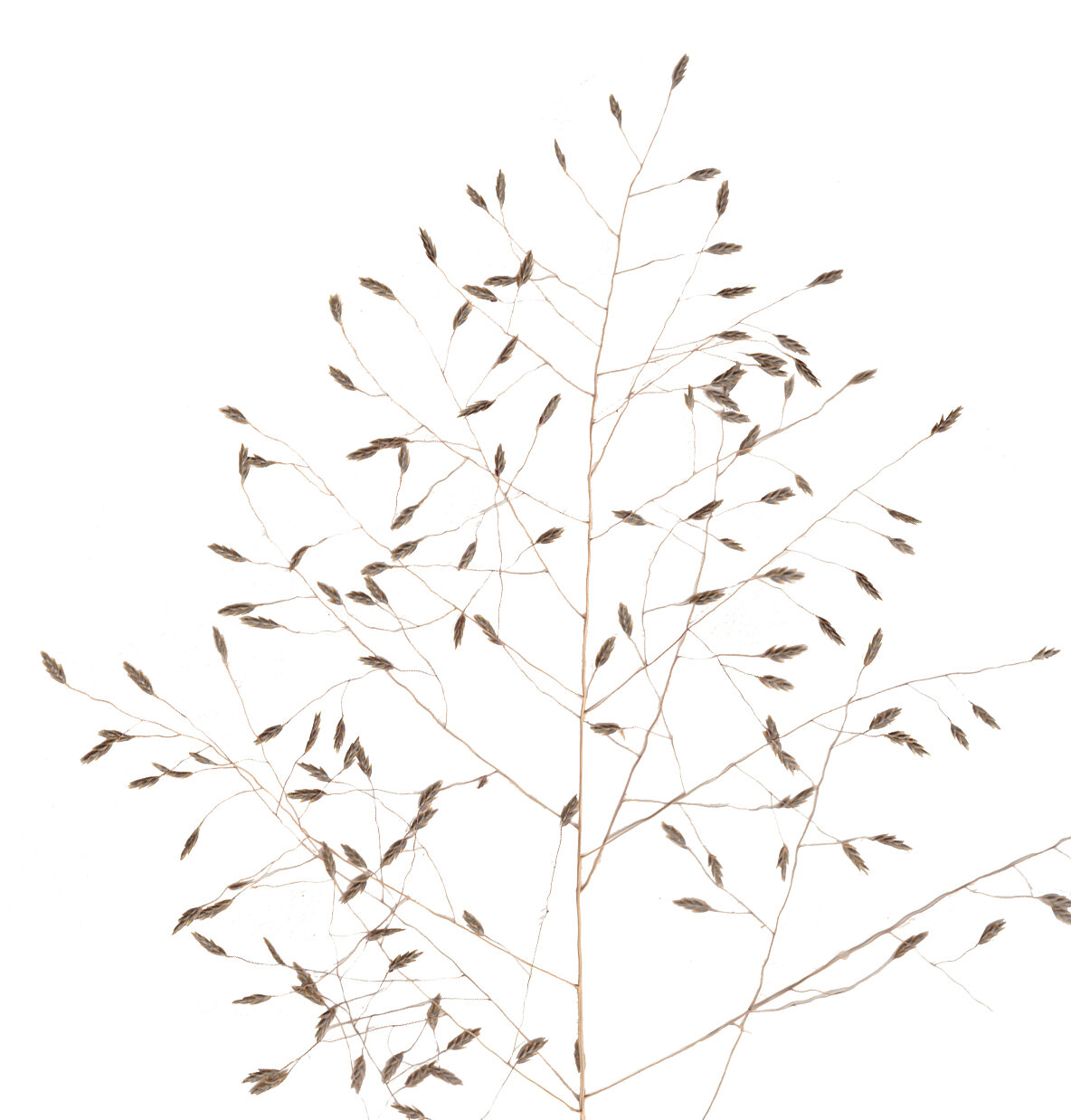Johnsongrass
Sorghum halepense
Johnsongrass is an invasive grass native to Asia and northern Africa. It reproduces by rhizomes and seeds and can grow to 7 feet tall. According to the Texas Invasive Species Institute, Johnsongrass can produce toxic amounts of cyanide if growing under stressful conditions, such as cold, extreme heat or drought and may be poisonous. It’s one of the most common weeds along roadsides and in ditches.
I culled most of the stems and all of the seeds before cooking the leaves in a solution of 1 cup soda ash to 3 gallons of water for 3 hours. After the initial cook, the fiber was rinsed thoroughly and cooked again in a fresh soda ash solution for an additional 2 hours. The rinsed grass was then processed in a Lander Critter for 5 hours.
Shaw, Robert. Guide to Texas Grasses. Texas A&M University Press, 2012.
Internet source: https://tsusinvasives.org/home/database/sorghum-halepenseRescuegrass
Bromus unioloides
Rescuegrass is an invasive introduced to the US from South America. An annual that can grow 3 feet tall, it’s easy to spot by its drooping, panicle inflorescence of flattened spikelets. Rescuegrass can be found throughout the US. Look for it in vacant lots, along roadsides and in open fields.
I cooked a 1/4 pound sample in soda ash for 1 hour and finished it in a blender. I used fresh grass so I’m sure it will fade but at this point, held up to the light, the paper is stunning. I’ll beat the next sample in the critter for a smoother sheet with shorter fiber.
Hemp with Rescuegrass
About 70% short-fiber hemp and 30% rescuegrass.
Gould, Frank. Common Texas Grasses An Illustrated Guide. Texas A&M University Press, 1978.
Speargrass
Nassella leucotricha
Speargrass is a perennial that has a lot of common names (Texas needlegrass, Texas wintergrass, Texas tussockgrass). If you come across it you’ll never forget it even if you don’t know its name.
Native from northern Mexico to Oklahoma it grows in calcareous, sandy, clayey soil. Look for speargrass in open grasslands, prairies and along roadsides (attached to your socks, shoes, and dogs). It grows 1-3 feet tall.
This paper sample has a lot of inclusions. You could easily beat it longer for a more uniform look.
Shaw, Robert. Guide to Texas Grasses. Texas A&M University Press, 2012.
Little Bluestem
Schizachyrium scoparium
Little bluestem is a perennial clump grass growing from 18 to 24 inches tall. It gets its name from the blueish color of its stems in the spring but by fall the stems are a beautiful rusty red color. Little bluestem grows in open woodlands, grasslands and prairies. Look for it along roadsides throughout the US and in parts of Canada.
Little bluestem paper is a pretty rust red just like its stems. I let the stems soak for at least 4 days and finished them in a blender after beating. I may have been able to avoid the additional soaking and possibly the blender if I had used a more caustic cooking agent than soda ash. Steaming is also an option.
I had some company, or maybe I should call it competition, on my hike. Although, Otto was just as interested in eating my bucket as he was the grass in it.
The paper has a nice look and feel.


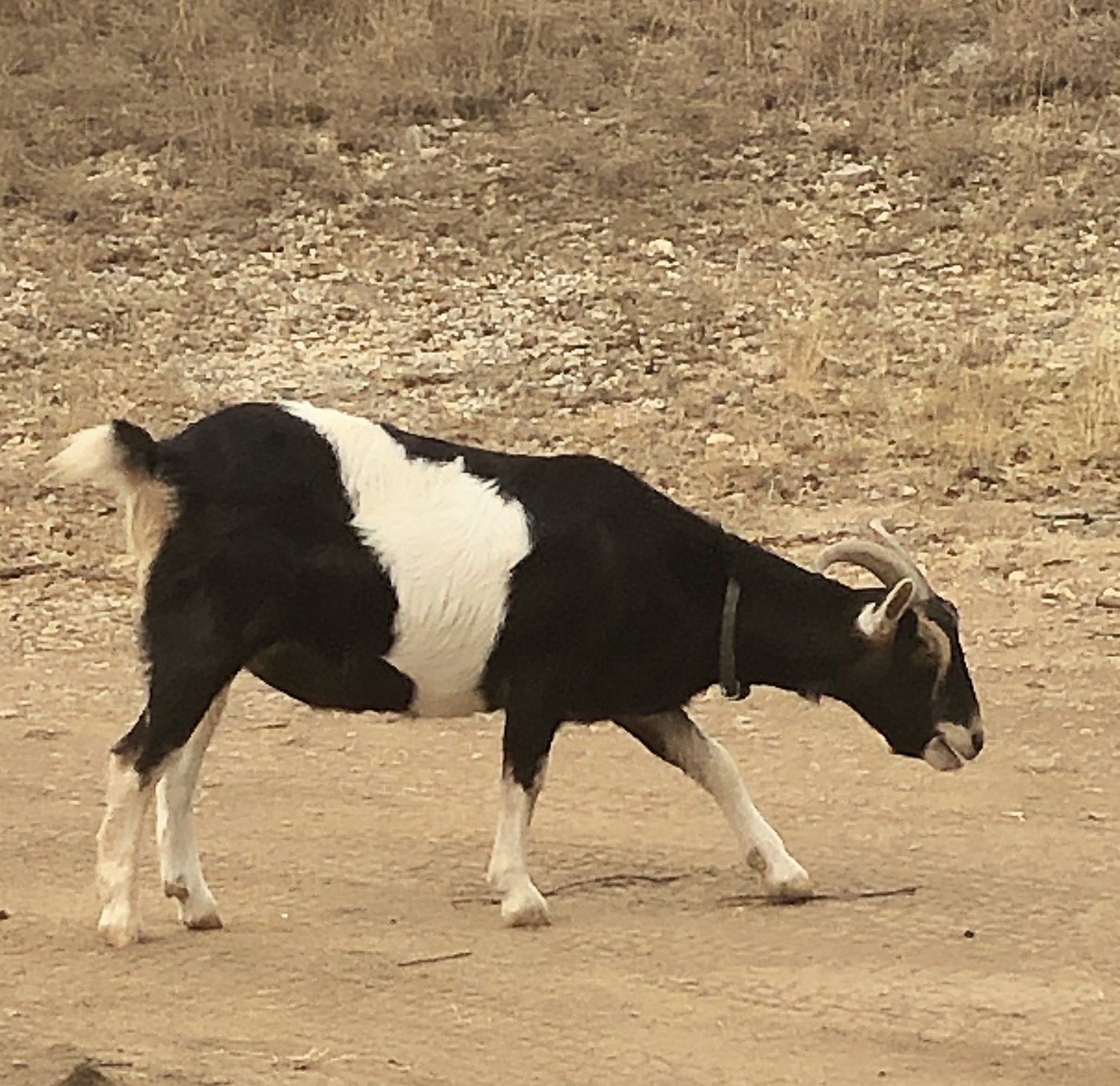


Cut, washed and ready for cooking.
Shaw, Robert. Guide to Texas Grasses. Texas A&M University Press, 2012.
Hairy Grama
Chondrosum hirsutum
Remember back when I said not all grasses make paper… well this is one of those that doesn’t. Hairy grama, also known as tall grama, is a very cool looking grass. It’s a perennial found in rocky areas or clay soils. It grows from 10 to 18 inches tall. When experimenting with fiber, sometimes it helps to know which grasses to avoid.
According to the USDA it’s native to all the lower 48 states. There are two subspecies of this grass that look very similar (to me). And I can’t promise that I didn’t miss identify this one but I doubt it would make much difference to our papermaking.
Shaw, Robert. Guide to Texas Grasses. Texas A&M University Press, 2012.
Gould, Frank. Common Texas Grasses An Illustrated Guide. Texas A&M University Press, 1978.
Sideoats Grama
Bouteloua curtipendula
Sideoats grama is the state grass of Texas. It’s a perennial growing 1 - 3 feet tall and is easy to identify with its purplish spikelets lining up along one side of the stem. Look for sideoats grama in open areas like prairies and rocky slopes in well drained sandy and clayey soils. It’s native to all lower 48 states and Canada.
I cooked the grass for 3 1/2 hours in soda ash and beat it for under an hour. Sideoats grama makes a nice paper with attractive inclusions.
Shaw, Robert. Guide to Texas Grasses. Texas A&M University Press, 2012.
Gould, Frank. Common Texas Grasses An Illustrated Guide. Texas A&M University Press, 1978.
Switchgrass
Panicum virgatum
Switchgrass is a cool season, perennial bunch grass with creeping rhizomes and tough stems. It’s native to most of the lower 48 states and Canada and can be found through much of Mexico to Central America. Switchgrass can grow 8 - 10 feet tall in open woodlands and prairies. You can also look for it along roadsides in sandy or clayey soils.
Switchgrass paper is strong with some subtle inflorescent inclusions. Depending on the size of the grass, you may want to soak the stems for a couple of days and add them to the beater first or break them down in a blender and then add them to your beater. The grass I harvested was about 2 feet tall.
Shaw, Robert. Guide to Texas Grasses. Texas A&M University Press, 2012.
Gould, Frank. Common Texas Grasses An Illustrated Guide. Texas A&M University Press, 1978.
Plains Lovegrass
Eragrostis intermedia
Plains lovegrass is a medium size perennial bunch grass growing from 1 to 3 feet tall. It’s found throughout the lower half of the U.S. down to South America. Look for it in sandy, clayey, rocky or disturbed soil.
A beautiful, light and delicate grass, Plains lovegrass doesn’t at first seem to be a good candidate for paper making but it does produce a strong paper with nice inclusions similar to Fall witchgrass. I cooked the dry fiber for 4.5 hours and beat it for 1.5 hours.
Shaw, Robert. Guide to Texas Grasses. Texas A&M University Press, 2012.
Gould, Frank. Common Texas Grasses An Illustrated Guide. Texas A&M University Press, 1978.
Windmillgrass
Chloris verticillata
Windmillgrass is a warm season perennial native to north central and western United States. It’s a compact grass growing from 6 to 18 inches tall. Look for it in sandy or gravelly soils.
Windmillgrass paper is strong with some rattle. The inflorescence provides some nice inclusions.
Shaw, Robert. Guide to Texas Grasses. Texas A&M University Press, 2012.
Gould, Frank. Common Texas Grasses An Illustrated Guide. Texas A&M University Press, 1978.
Plains Bristlegrass
Setaria luecopila
Plains bristlegrass is a perennial bunchgrass growing in the southern plains of the United States and northern Mexico. Plains bristlegrass is native to Texas, Oklahoma, New Mexico, Arizona, Arkansas, and Florida. It can grow up to 4 feet tall in open and fairly dry and rocky ground. The grass I harvested was about 2 feet tall. In general, I avoid the taller grasses because the tough stems require more soaking and beating time.
Plains bristlegrass makes a strong paper with little rattle. The seeds and awns provide nice subtle inclusions.
Shaw, Robert. Guide to Texas Grasses. Texas A&M University Press, 2012.
Gould, Frank. Common Texas Grasses An Illustrated Guide. Texas A&M University Press, 1978.
Silver Bluestem
Bothriochloa saccharoides (Bothriochloa laguroides)
Silver bluestem is a beautiful grass growing 3 - 6 feet tall with a silky inflorescence. It’s common to all lower 48 states and fairly easy to identify. Generally you'll find it in open spaces or along roadsides in sandy soil.
Silver bluestem is a perennial bunch grass with a conspicuous basal cluster of leaves and stems which helps in identification.
It produces a paper with little rattle. The texture is nice but you can leave the fiber in the beater longer for a smoother sheet.
Shaw, Robert. Guide to Texas Grasses. Texas A&M University Press, 2012.
Gould, Frank. Common Texas Grasses An Illustrated Guide. Texas A&M University Press, 1978.
White Tridens
Tridens albescens
White tridens is my favorite. It’s a warm season perennial grass with stems approximately 1-3 feet tall. It usually grows in clayey soils in areas that receive an abundance of drainage water. Look for it in ditches, swales, and along road sides.
White tridens is native to Texas, Oklahoma, Louisiana, Kansas, New Mexico and Arizona.
This grass produces a strong paper with just a bit of rattle. The seed inclusions add beautiful flecks of reddish brown.
Shaw, Robert. Guide to Texas Grasses. Texas A&M University Press, 2012.
Gould, Frank. Common Texas Grasses An Illustrated Guide. Texas A&M University Press, 1978.
Notes on Papermaking
Harvesting
Identifying grass for harvesting is much easier when the grass is blooming. Plus the inflorescence or flowering portion of the plant adds beautiful inclusions and texture to paper.
Purchase an app or book to help in identification. You can also contact your Native Plant Society chapter for a schedule of plant identification classes or (in Texas) Bamberger Ranch. Selah, Bamberger Ranch Preserve, usually has at least one grass identification hike on their schedule every year.
I generally carry Common Texas Grasses by Frank W. Gould with me when I go hiking. In the studio I use Guide to Texas Grasses by Robert B. Shaw. This is a wonderful book filled with illustrations, photographs and maps. Most of the grasses we’ll make paper with are common in other states as well as Texas but you may want to find a reference guide specific to your area.
Since most plants have more than one common name, use the scientific name when identifying.
Cut the stems about 3” above the ground, leaving the root in place (if it’s a native). You’ll need a solid container like a bucket, no mesh or wire, for your cuttings. You’ll want to collect the entire inflorescence. There is some concern about spreading non-native seeds through papermaking and I respect that, but I’ve never had a seed survive the cooking and beating process. Also, keep in mind grass seeds contain cellulose. I’m not sure the grass fiber would bond without the added cellulose from the seeds. If you want to include live seeds to create plantable cards, add them to the pulp right before you make your paper.
I work with both fresh and dry fiber—sometimes harvesting and storing the grass for pulping at a later time. I cut about 1/4 pound of grass to test.
Soaking
I only soak the big grasses with tough or woody stems and generally not more than 24 hours. Line your soaking bucket with a paint strainer to catch the loose seeds and awns.
Cooking
Cut the grass into 2-3 inch pieces. Use 1/2 to 3/4 cup soda ash per pound of dry grass. Cooking time averages 2-3 hours.
Rinsing
Drain the cooked fiber through a paint strainer. Gently wash the seeds and awns into the rinse bucket. Rinse until the water runs clear.
Beating
I use a Lander Critter. Plan on approximately 3 hours. You may need to separate the woody stems and finish them in a blender.
Sheet Formation
If the grass isn’t couching easily, add some formation aid. You can use a pellon for the more delicate fiber.
There are over 11,000 species of grass in the world including 500+ in my native state of Texas. This makes grass the perfect renewable fiber source. While not every grass makes a strong sheet of paper enough do that I believe it’s worth the effort to explore.
Hopefully having a new and interesting fiber source will encourage more papermakers to learn about the role grass plays in nature. The more we understand about the importance of planting natives the better land stewards we will become and possibly papermakers with a larger pallet.
To learn more about native grasses in your area look to your local Native Plant Society chapter, (in Texas) www.npsot.org, or your local Agricultural Extension Office.
Happy papermaking!







